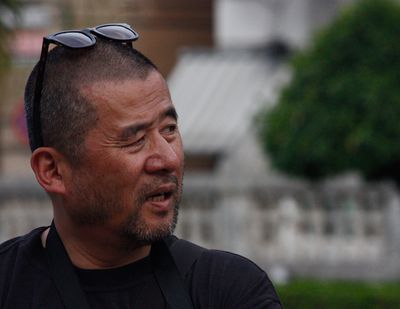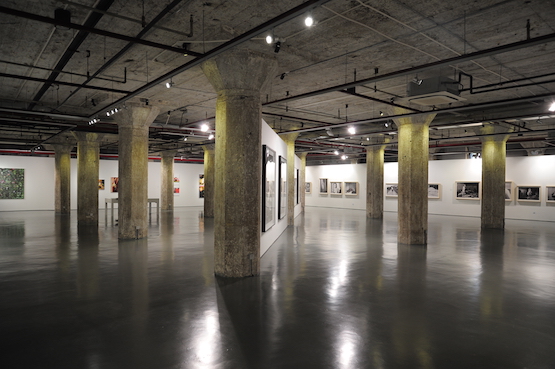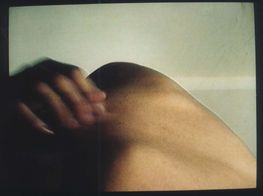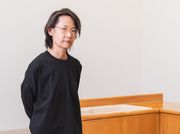Zhang Peili

In terms of Chinese video art, Zhang Peili is omnipresent: he’s celebrated as a pioneering practitioner, he teaches it as a professor at the China Academy of Art, and he’s instrumental in getting it shown as Director of OCAT Shanghai, the city’s leading art space for video. In September of this year, Zhang also curated a selection of Chinese video art for the Photo Shanghai art fair.
You’re often described as the father of Chinese video art. What do you think of that description? Do you agree that you were the first Chinese artist to use video, and that 30x30 (1988) is the first Chinese video art work? What motivated you to start using video in your practice?
Whether or not 30x30 is the earliest Chinese video art work, I don’t really care. To me, that doesn’t really mean anything. In fact, at the end of the ’80s I started to use video to create works; it was part of an ongoing period of practice, not at all an isolated work. Of course, there was a relationship between the wider environment at the time and my work then. It really wasn’t a sudden or random thing. But at that time, I didn’t really consider what it was too much. I only truly realised video could be a method of creating works in the ’90s. This moment of realisation is clearer to me than which was the first video work.
Can you tell us about the ways other Chinese artists were using video around the time that you started? Were there international artists who inspired your use of video?
Before I made my earliest works, 30x30, Hygiene No. 3, Water—Standard Version from the Dictionary Ci Hai, at least these three, I hadn’t yet been overseas, and within China I hadn’t seen any video works, certainly not foreign artists’ video works. I knew artists like Nam June Paik and Bruce Nauman were making videos, but I’d only seen their works in magazines, and didn’t have a clear picture of them—just stills from TV screens. I think video works are connected to environment; environments contain information, this is of course not about the information provided merely by foreign video art, since you couldn’t have found any in China. At that time, the environmental information included films, music, literature and so on. I travelled to the US and Europe in the ’90s, and I won’t deny that [this experience and exposure to international video art was influential], and my video art greatly changed. After the ’90s, regardless of nationality, all artists have been able to communicate face to face. It’s hard to clarify who are the sources or the receivers of which influences.
OCAT, Shanghai. Image courtesy OCAT Shanghai
In works such as Last Words (2003) and Happiness (2006), you satirised revolutionary films. What do you make of Chinese cinema today?
I haven’t seen many contemporary Chinese films. The strange thing is, in my understanding, a film is mainly a kind of visual art presented with narratives. As I recall, the old films I watched when I was little were more infectious than the current films regarding either narratives or the power of the language. Nowadays, films seem lifeless and phony. Of course we are aware that that the films themselves are unreal, but it would be an insult for the audience, knowing films are staged to still feel that they are fake. All this time I’ve been thinking that one of the most influential features of cinema is that it can trick the audience with their [own] eyes. Some films don’t seem to narrate anything, and nor are they good at story-telling or making money, let alone being experimental. At the beginning of the 1980s, there still existed some experimental films with huge influence, and the directors were more enthusiastic to try out new things. The control over language and the imagination—or to put it simply, the talent to direct is the fundamental thing (be it for films or videos). Both narrative and non-narrative films require talent in the same sense that painting on easels and making videos also requires talent. Disposing of talent is equivalent to wasting money and abusing the audience’s eyes.
You also make works that seem inspired by video but are realised in more traditional media. Is it important for new media artists to also produce work in traditional media?
I don’t bother myself with too much consideration before doing something. An artist can do anything; traditional media and new media are both valid kinds of art. It is unreasonable to say that an artist who uses mainly new media shouldn’t engage in any traditional media, and we all started off using traditional media anyways, and this kind of memory still exists. Moreover, the efficient combination of traditional and new media could lead to the creation of a new language, which is an interesting experiment. For me, making prints is more like experimenting or playing.
Do you think artists and galleries are getting better at selling video art works? What do you think is the best model for selling digital art works that can be reproduced again and again at almost zero cost?
That’s very complicated. Up until now, although the commercial sales of video art works have experienced some changes during the past one or two decades, it is not very promising. It is largely to do with the unchangeable characteristics of the medium of video art, [and] therefore the environment is unchangeable as well. As mentioned in your question, it can be endlessly reproduced at nearly zero cost. Almost everything can be replicated countless times, but its value will nevertheless be unstable. For this reason, collectors may feel insecure. The problem has yet not been completely solved by either collectors, galleries or artists, and they also have little idea about which model is the best. The artists are more focused on art works, and sales would be like pennies from heaven for them. So if a medium cannot form a positive cycle starting from producing and showing to critical reception and collecting, that would be a problem. I can’t seem to find a way to solve that in a short time, so I’ll keep taking things one-step at a time.
You’re the director of OCAT Shanghai, which has championed video art since it opened in 2012. What do you think have been your greatest accomplishments during your time there? What do you hope to accomplish there in the next year or so?
I haven’t really done much during the three years of my directorship. OCAT only has four exhibitions and some public education programs each year, and you can only do very limited things with it. I’ve always tried hard to appeal to audiences whether they know about art with artworks from different countries and periods in order to help them discover that video art actually belongs to the common people and reflects their daily lives. That’s what I want to do. I don’t really expect myself to achieve anything big during these years, but if I have to say something, then the goal is to let more people know that OCAT is a professional non-profitable art museum that’s mainly concerned with new media and video art. I have confidence and hope in the future development of OCAT, and I especially want to continuously promote new artists via this platform. As a matter of fact, the past few years have seen the recognition of some young artists.
Exhibition space, OCAT. Image courtesy OCAT Shanghai
You curated the Moving Image Programme at Photo Shanghai. What were your criteria for selecting the works?
The language needs to be vigorous and simple. And the work needs to effectively make use of this special feature of videos to most directly and clearly express what the artist wishes to say. Most of the works were non-narrative and non-documentary. Some of them are performance art, but I don’t think they are realistic, because the artists display imaginary things through videos and performances. There weren’t any specific criteria during the process of selection, but the works should be representative of artists of different age groups with different directions and aspirations creating in recent years.
Would you introduce a few of your favorite videos you showed in the Moving Image Programme?
This is really hard; the whole watching process was an enjoyable one. There have been quite a few high-quality works, which made me very delighted, I myself was immersed in the moment, and wouldn’t have cared which was the focus in those works, what I intended to create was a fresh visual atmosphere as a whole. —[O]














































































































































































